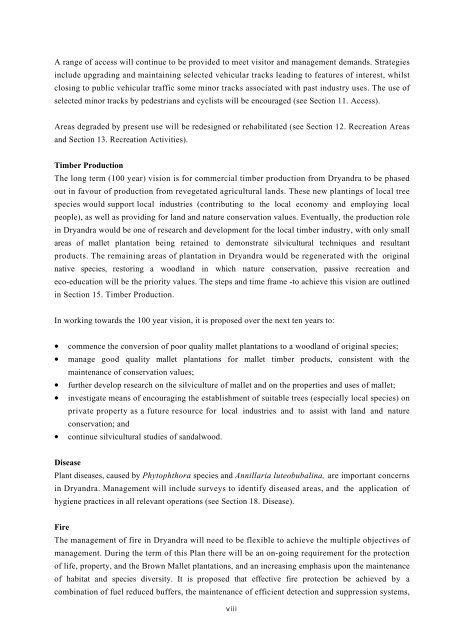Dryandra Woodland - Department of Environment and Conservation ...
Dryandra Woodland - Department of Environment and Conservation ...
Dryandra Woodland - Department of Environment and Conservation ...
You also want an ePaper? Increase the reach of your titles
YUMPU automatically turns print PDFs into web optimized ePapers that Google loves.
A range <strong>of</strong> access will continue to be provided to meet visitor <strong>and</strong> management dem<strong>and</strong>s. Strategies<br />
include upgrading <strong>and</strong> maintaining selected vehicular tracks leading to features <strong>of</strong> interest, whilst<br />
closing to public vehicular traffic some minor tracks associated with past industry uses. The use <strong>of</strong><br />
selected minor tracks by pedestrians <strong>and</strong> cyclists will be encouraged (see Section 11. Access).<br />
Areas degraded by present use will be redesigned or rehabilitated (see Section 12. Recreation Areas<br />
<strong>and</strong> Section 13. Recreation Activities).<br />
Timber Production<br />
The long term (100 year) vision is for commercial timber production from <strong>Dry<strong>and</strong>ra</strong> to be phased<br />
out in favour <strong>of</strong> production from revegetated agricultural l<strong>and</strong>s. These new plantings <strong>of</strong> local tree<br />
species would support local industries (contributing to the local economy <strong>and</strong> employing local<br />
people), as well as providing for l<strong>and</strong> <strong>and</strong> nature conservation values. Eventually, the production role<br />
in <strong>Dry<strong>and</strong>ra</strong> would be one <strong>of</strong> research <strong>and</strong> development for the local timber industry, with only small<br />
areas <strong>of</strong> mallet plantation being retained to demonstrate silvicultural techniques <strong>and</strong> resultant<br />
products. The remaining areas <strong>of</strong> plantation in <strong>Dry<strong>and</strong>ra</strong> would be regenerated with the original<br />
native species, restoring a woodl<strong>and</strong> in which nature conservation, passive recreation <strong>and</strong><br />
eco-education will be the priority values. The steps <strong>and</strong> time frame -to achieve this vision are outlined<br />
in Section 15. Timber Production.<br />
In working towards the 100 year vision, it is proposed over the next ten years to:<br />
• commence the conversion <strong>of</strong> poor quality mallet plantations to a woodl<strong>and</strong> <strong>of</strong> original species;<br />
• manage good quality mallet plantations for mallet timber products, consistent with the<br />
maintenance <strong>of</strong> conservation values;<br />
• further develop research on the silviculture <strong>of</strong> mallet <strong>and</strong> on the properties <strong>and</strong> uses <strong>of</strong> mallet;<br />
• investigate means <strong>of</strong> encouraging the establishment <strong>of</strong> suitable trees (especially local species) on<br />
private property as a future resource for local industries <strong>and</strong> to assist with l<strong>and</strong> <strong>and</strong> nature<br />
conservation; <strong>and</strong><br />
• continue silvicultural studies <strong>of</strong> s<strong>and</strong>alwood.<br />
Disease<br />
Plant diseases, caused by Phytophthora species <strong>and</strong> Annillaria luteobubalina, are important concerns<br />
in <strong>Dry<strong>and</strong>ra</strong>. Management will include surveys to identify diseased areas, <strong>and</strong> the application <strong>of</strong><br />
hygiene practices in all relevant operations (see Section 18. Disease).<br />
Fire<br />
The management <strong>of</strong> fire in <strong>Dry<strong>and</strong>ra</strong> will need to be flexible to achieve the multiple objectives <strong>of</strong><br />
management. During the term <strong>of</strong> this Plan there will be an on-going requirement for the protection<br />
<strong>of</strong> life, property, <strong>and</strong> the Brown Mallet plantations, <strong>and</strong> an increasing emphasis upon the maintenance<br />
<strong>of</strong> habitat <strong>and</strong> species diversity. It is proposed that effective fire protection be achieved by a<br />
combination <strong>of</strong> fuel reduced buffers, the maintenance <strong>of</strong> efficient detection <strong>and</strong> suppression systems,<br />
viii

















